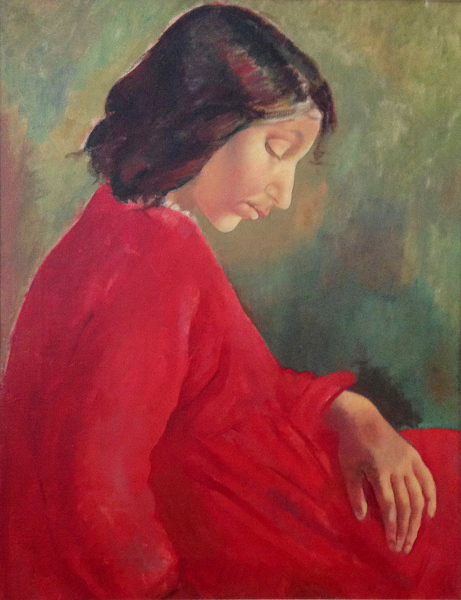

 Hover over the painting to magnify (there may be an initial delay while the magnified image is loaded)
Hover over the painting to magnify (there may be an initial delay while the magnified image is loaded)Clara Klinghoffer (1900-1970):
The Artist's Sister, 1919
Framed (ref: 6379)
Signed and dated on reverse
Oil on canvas
26 1/4 x 21 1/2 in. (67 x 55 cm)
See all works by Clara Klinghoffer oil portraits women Fifty Works by Fifty British Women Artists 1900 - 1950 WOMEN
Provenance: With the current owner's family since 1938
Clara Klinghoffer was born in Szerzezec (now Lemberg), a village near Lwów (now Lviv), in that contested region that was once Poland, and which at the time of her birth was part of the Austro-Hungarian Empire and is now in Ukraine. Her Jewish parents immigrated to England in 1903, settling first in Manchester and then in the East End of London.
Klinghoffer displayed an early aptitude for art. She studied at the Slade immediately after the Great War and was quickly recognised as an impressive young talent, holding her first one-woman exhibition at the Hampstead Gallery in 1919. Her work was heavily influenced by the High Renaissance artists so admired by her teacher, Henry Tonks. Indeed, in 1937 Mary Chamont would write in Modern Painting in England that Klinghoffer’s drawings “were comparable to the great Italian masters”. Her early paintings, however, were a rather different affair. This portrait of one of her six sisters, with its bold use of colour and naïve execution, clearly reveals the modernist influence of fellow Jewish artists such as Bernard Meninsky, Jacob Kramer and Mark Gertler.
Whilst Klinghoffer enjoyed early recognition, one leading critic, PG Konody of The Observer, was not alone in expressing disappointment in her subsequent development: “Miss Clara Klinghoffer’s undeniable accomplishment and sensitive draughtsmanship seem to have led her into a blind alley”, he complained in 1925, “from which she does not even attempt to escape. Each new drawing of her familiar types is like an unnecessary assertion of her cleverness. Her chief merit lies in her appreciation of the plastic life contained within the contours of the human figure.”
Commentary by David Boyd Haycock, freelance writer and curator with a specialism in British art of the early twentieth century. He is the author of a number of books, including A Crisis of Brilliance: Five Young British Artists and the Great War (2009).
 Unsung Heroines
Unsung Heroines SOLD
SOLD




